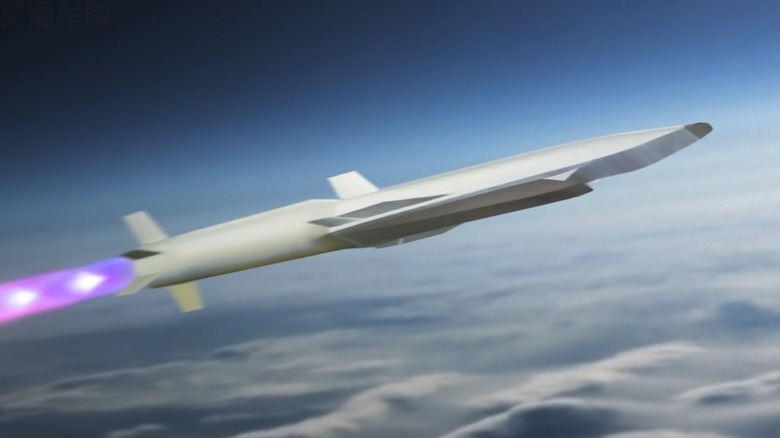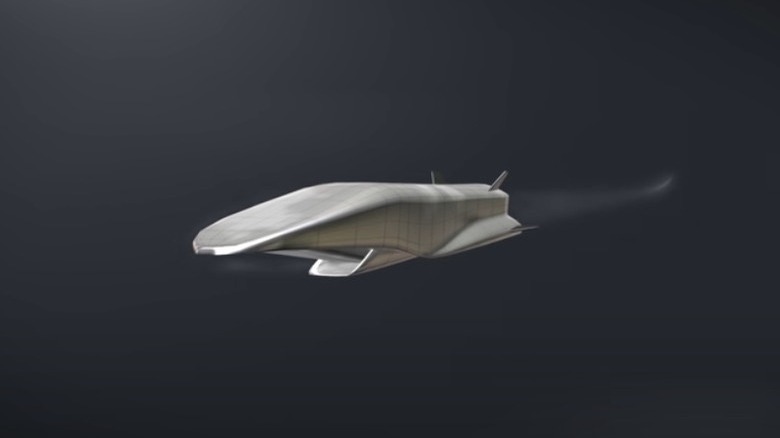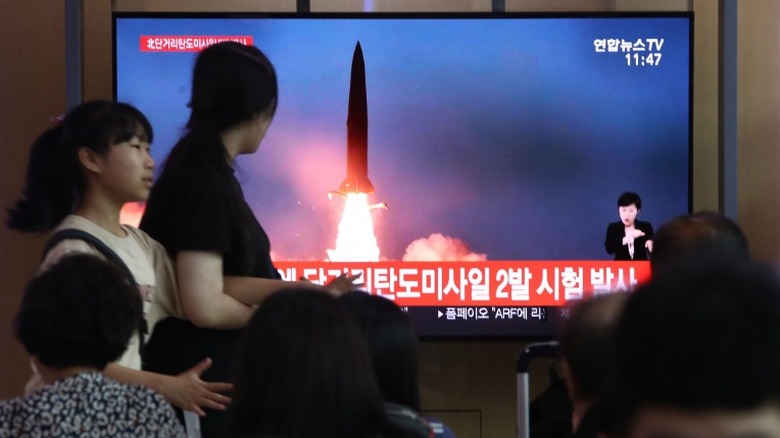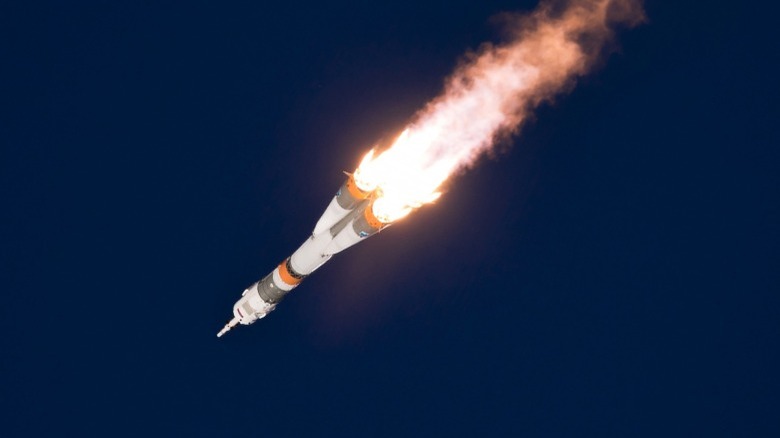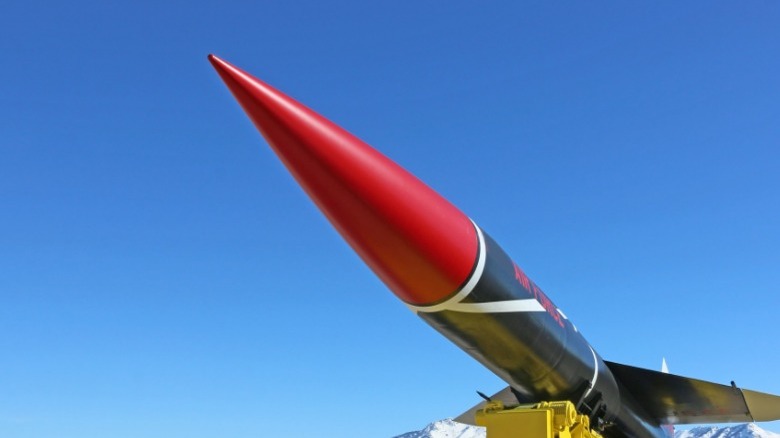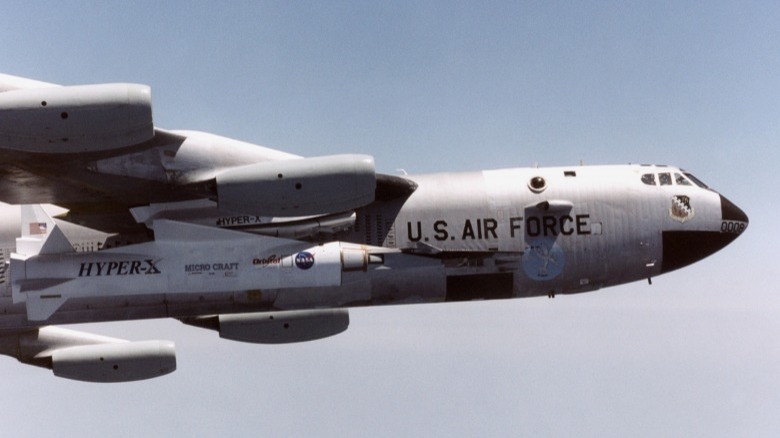The Untold Truth Of Hypersonic Missiles
Hypersonic missiles are the latest must-have military gadget. Leading powers such as the United States, Russia, and China are competing with each other to produce the most powerful and effective variants. According to the National Interest, Congress allocated $400 million to the Missile Defense Agency (MDA) in 2020 for work on hypersonic missiles. For the 2022 budget, the MDA asked for a further $248 million (via USNI News).
Meanwhile, the People's Liberation Army in China is prioritizing hypersonic glide technology, according to geopolitical expert Richard D. Fisher (via the Sunday Guardian Live), who adds that the true extent of China's commitment to hypersonic missiles cannot be estimated by their dishonest military budget. Defense News reports that hypersonic missiles are also a priority for Russia, which has the fourth largest military budget in the world, according to the Stockholm International Peace Research Institute.
However, despite this clear demand from powerful governments, there is no clear consensus on hypersonic missiles. Military officials say they will "revolutionize warfare," according to the Scientific American, while others dismiss them as "weapons that don't work to meet threats that don't exist." Here is the untold truth of hypersonic missiles.
The first hypersonic missile was launched in 1949
According to British science writer David Darling, the first successful hypersonic missile was launched on February 24, 1949. It was the fifth of eight missiles that combined the German V2 rocket with American WAC Corporal technology, and it launched from the White Sands Proving Ground in New Mexico, the location where Trinity, the world's first atomic bomb, was detonated on July 16, 1945 (via the National Parks Service).
The successful hypersonic missile reached an altitude of 244 miles, which was a record until 1957, and a speed of at least 5,150 mph. It was the first human object to achieve hypersonic speeds, and it would take over a year before its broken remains were found in the desert.
The other seven launches were unsuccessful, with the report citing issues from "premature cutoff" and "low angle firing" to "second stage did not ignite" and "explosion following cut off."
There are two types that travel at speeds beyond Mach 5
Hypersonic missiles travel at Mach 5, which is five times the speed of sound, or 3,836 mph, according to James Bosbotinis, a specialist in defense and international affairs (via Part Yard). To put that speed in perspective, it is roughly seven times faster than the U.S. Tomahawk cruise missile, which reaches speeds of around 550 mph. Also, a hypersonic missile could fly from New York to Beijing in just 1 hour and 40 minutes, according to the Carnegie Endowment.
Hypersonic missiles come in two variants, and they achieve their speeds with different technology. As Bosbotinis details, hypersonic cruise missiles use jet engines that power the missiles within the Earth's atmosphere. Hypersonic glide vehicles, the second type, also have powerful jet engines. But this variant is launched into space before gliding back to earth, similar to an intercontinental ballistic missile (ICBM). However, what distinguishes these hypersonic missiles from ICBMs is that they are attached to a glide vehicle, which uses aerodynamics to manage shockwaves and penetrate missile defenses through a combination of maneuverability and dizzyingly high speeds of over one mile per second.
The technology is led by the U.S., China, and Russia
The U.S., Russia, and China lead in the development of hypersonic missiles. In the U.S., funding is expected to reach $15 billion between 2015 and 2024, which is an increase of over 740% (via Bloomberg). Research and production is conducted by the U.S. Navy, the U.S. Air Force, and the Defense Advanced Research Projects Agency. However, despite this funding and support, the U.S. is said to be "at least several years behind" China's capabilities, according to Gregory Hayes, the CEO of Raytheon Technologies Corp.
China has launched several hypersonic missiles in recent years, including various ballistic missiles that can launch hypersonic glide vehicles. These include the DF-17, a medium range ballistic missile, and the DF-41, an intercontinental ballistic missile that could carry a nuclear glide vehicle, as per Bloomberg. These tests could create a weapon that combines the speed and maneuverability of a hypersonic glide vehicle with the terrible destructive power of a nuclear warhead.
Russia's hypersonic missile program includes the Avangard, which is a glide head with nuclear capabilities that entered service in December 2019, according to Russian media (via Bloomberg). Another weapon is the Tsirkon, a cruise missile that is launched from ships and can hit both sea and land-based targets.
Other countries are conducting research
According to Bloomberg, India, Japan, Australia, France, Germany, and North Korea have also tested their own hypersonic missiles. In October 2020, the Arms Control Association reported that India had worked with Russia to develop the Brahmos II, a hypersonic cruise missile that's designed to challenge China's hypersonic capabilities. Relations between the two countries, which are home collectively to almost 3 billion people, have been tense in recent years, especially in June 2020 when a border clash killed 20 Indian soldiers and four Chinese soldiers (via CNBC).
According to Defense News, Japan announced on March 13, 2020, that it was launching both hypersonic cruise missiles and gliding vehicles. Like India, Japan is wary of China's increased aggression in the region (via Wall Street Journal).
In the European Union, France and Germany are the lead participants in the TWISTER program, which is an acronym for Timely Warning and Interception with Space-Based Theater Surveillance (via Defense News). Lt. Gen. Heinrich Brauß said that this program was needed to protect European airspace, adding that it met the threat posed by Russia's intermediate-range missiles.
Perhaps the most dubious player in the hypersonic missile race is North Korea. On September 29, 2021, the BBC reported that the dictatorship had launched a hypersonic missile named Hwasong-8. Speaking at the United Nations, North Korea envoy Kim Song said the country was "building up our national defense in order to defend ourselves and reliably safeguard the security and peace of the country."
The U.S. was 'very concerned' about China's launch
The Guardian reported that Gen. Mark Milley, chairman of the Joint Chiefs of Staff, described China's launch as close to a Sputnik moment. Referring to China's missile test on July 27, 2021, Milley added, "What we saw was a very significant event of a test of a hypersonic weapon system, and it is very concerning."
The July launch successfully orbited a nuclear-capable glider that achieved hypersonic speed and several position adjustments after re-entering the Earth's atmosphere. According to Guardian correspondent Julian Borger, a weapon like this could be used to strike the U.S. from the South Pole, which would avoid America's north-facing ballistic missile defense (BMD) interceptors.
MIT professor Vipin Narang said, "China realized it needed to compete with the U.S. in order to stalemate us at the strategic nuclear level, to have a capability that could give the U.S. pause before the U.S. used nuclear weapons first in a conventional conflict" (via The Guardian).
The Biden administration says the U.S. has no defense
On October 20, 2021, Reuters reported that President Joe Biden was concerned about China's progress with hypersonic missiles — his remarks coming just days after Beijing had tested such a weapon. According to Robert Wood, a U.S. envoy for disarmament, the Biden administration has "concerns about what China is doing on hypersonic ... We just don't know how we can defend against that technology, neither does China or Russia," as per the Independent.
Other Washington figures have expressed their concern, such as Maine Sen. Angus King, who said, "Hypersonic weapons are strategic game-changers with the dangerous potential to fundamentally undermine strategic stability as we know it ... the U.S. cannot lag in this development or allow for blind spots as we monitor the progress of our competitors" (via Reuters).
Much of this fear comes from the speed and agility of hypersonic missiles. To combat this, Naval News reports that the U.S. Department of Defense is developing the Next Generation Interceptor. According to representative Leonor Tomero, this system will "bring a more integrated approach to air and missile defense to address various types of ballistic missile threats and enable defense against cruise missiles and unmanned aerial systems."
The missiles are weak in their 'terminal stage'
Despite the power and agility of hypersonic missiles, National Interest reported that they are vulnerable in their "terminal phase." David Axe wrote that while hypersonic missiles are "impossible" to intercept during the middle of their flight, which some refer to as the "midcourse" phase, they are easier to target in the last or "terminal" phase because their speed lowers.
Academics writing in Spectrum argue that the comparatively low speeds during the terminal phase causes hypersonic weapons to have little to no advantage over existing missiles, which also have a chance of evading defense systems when used in appropriate tactics and numbers.
Furthermore, the U.S. can use the Navy Carrier Strike Group to engage hypersonic missiles in their terminal stage (via Defense News). A leading ship in this group is the Aegis, which can engage these missiles when they are around 40 miles away. This defense technology is to be bolstered by new systems such as the Hypersonic and Ballistic Tracking Space Sensor (HBTSS), which is a low-earth orbit satellite that can track hypersonic missiles in flight.
They are extremely accurate
The U.S. may feel that it is somewhat lagging behind China's hypersonic missile program. However, a Defense News article reported that American hypersonic missiles can hit within six inches of their target. This was achieved during a launch of a Common-Hypersonic Glide Body (C-HGB) in March 2020. Launched from the Pacific Missile Range Facility in Kauai, Hawaii, the operation was led by a "top notch team of individuals from across government, industry and academia," according to Navy Vice Adm. Johnny Wolfe.
This precision accuracy is vastly different to bombing technologies of the past. For example, the 1941 Butt Report found that just 5% of bombs dropped by British bombers landed within 5 miles for their target (via Military Histories).
However, hypersonic missiles could achieve even greater accuracy. According to the South China Morning Post, missiles could be 10 times more accurate if the guiding systems are controlled by machines rather than human operators. This is despite the extreme pressures hypersonic missiles endure when they reach hypervelocity. At some points, the aircraft can become hotter than the sun's surface, which hampers its ability to read GPS signals or the Earth's magnetic field.
America's hypersonic testing has been troubled
On September 28, 2021, Forbes writer David Axe wrote that the Pentagon had finally tested a hypersonic missile without "screwing it up." Fifteen months prior, on June 10, 2020, Aviation Weekly reported that an experimental missile separated from a B52 bomber, which was flying as part of the 419th Flight Test Squadron at Edwards Air Force Base in California.
The exact circumstances of the mishap are classified, but Aviation Week speculated that it could have occurred over a test range such as the Edwards Precision Impact Range Area or Naval Air Weapons Station test range at China Lake. This accident happened after the project had fallen several months behind schedule.
America's fortunes changed with the test in September 2021, which successfully deployed the Hypersonic Air-Breathing Weapon Concept (HAWC) at speeds beyond Mach 5. U.S. Defense Advanced Research Projects Agency (DARPA) representative Andrew Knoedler said, "The HAWC free flight test was a successful demonstration of the capabilities that will make hypersonic cruise missiles a highly effective tool for our warfighters."
The U.S. has a 'super duper missile'
In May 2020, President Donald Trump stated that the U.S. had what he called a "super duper missile" (via Popular Mechanics). As he established the Space Force at a White House conference, Trump said that the missile was "17 times faster than what they have right now."
Popular Mechanics speculated that the "super duper missile" is most likely the AGM-183 ARRW, a 1,000-mile range weapon that can reach speeds of Mach 12, which means it could hit its maximum range target in just seven seconds. This is much, much faster than a conventional Tomahawk missile, which would take an hour and 20 minutes to strike such a target. In addition, the AGM-183 ARRW is said to hit its target within just 14 inches.
However, as impressive as this may be, Trump is infamously loose with the facts (via The Washington Post). The announcement could have been a ploy to alarm China and Russia, who may spend huge sums of money to tackle the threat posed by the "super duper missile."
Some experts doubt their effectiveness
According to Andrew Cockburn, hypersonic missiles are "weapons that don't work to meet threats that don't exist." He added that hypersonic missiles are not a "worthwhile weapon of war," and that there is "no new threat here" because they are not sufficiently distinguishable from ICBMs. This is because ICBMs, like hypersonic missiles, can also evade most missile defense systems despite all of the expensive research conducted since Ronald Reagan's "Star Wars" program in 1983 (via History).
Cockburn's stance is corroborated by Cameron L. Tracy and David Wright (via The Spectrum), who hold doctorate degrees in materials science and physics, respectively. The academics describe hypersonic missiles as an "old technology," citing how the U.S. ditched hypersonic missiles in the 1960s for ballistic and cruise missile technologies because hypersonic missiles were too expensive and without a clear objective.
The scientists also argued that the extreme heat generated by hypersonic speed degraded the missiles' aerodynamics and caused them to be vulnerable to heat-seeking defense sensors.
In answering why there is a sudden craze around hypersonic missiles, Tracy and Wright suggested that it was a symptom of the "bureaucratic processes" of military budget making that exaggerates the "revolutionary" qualities of their research to attract government financing.
